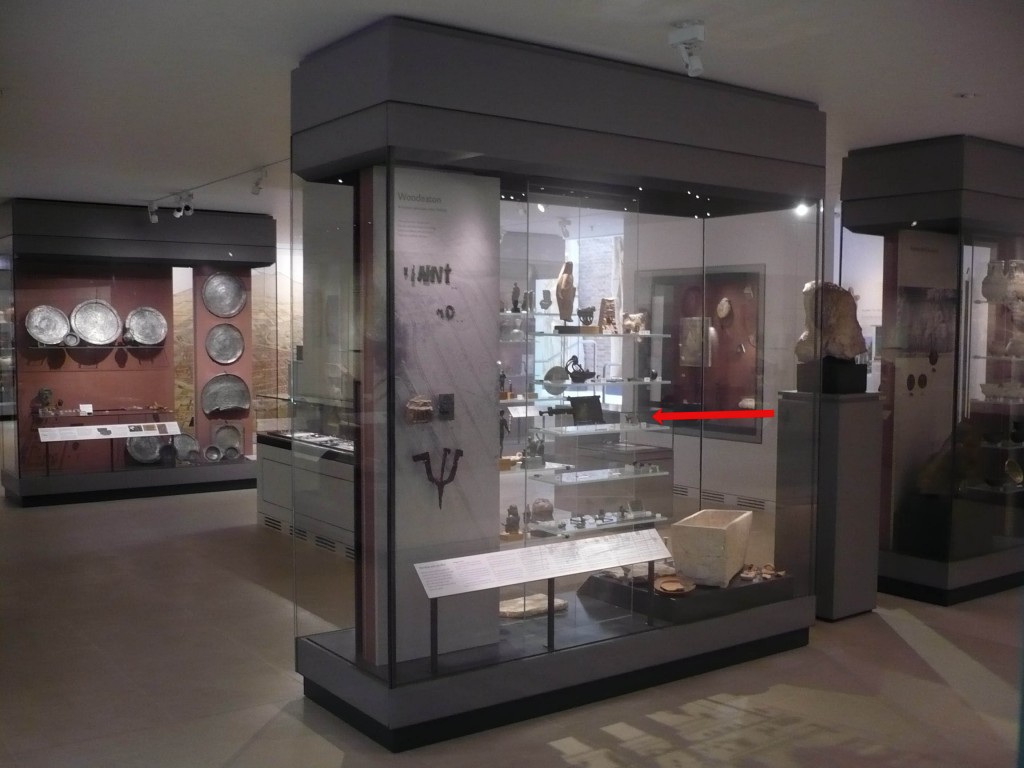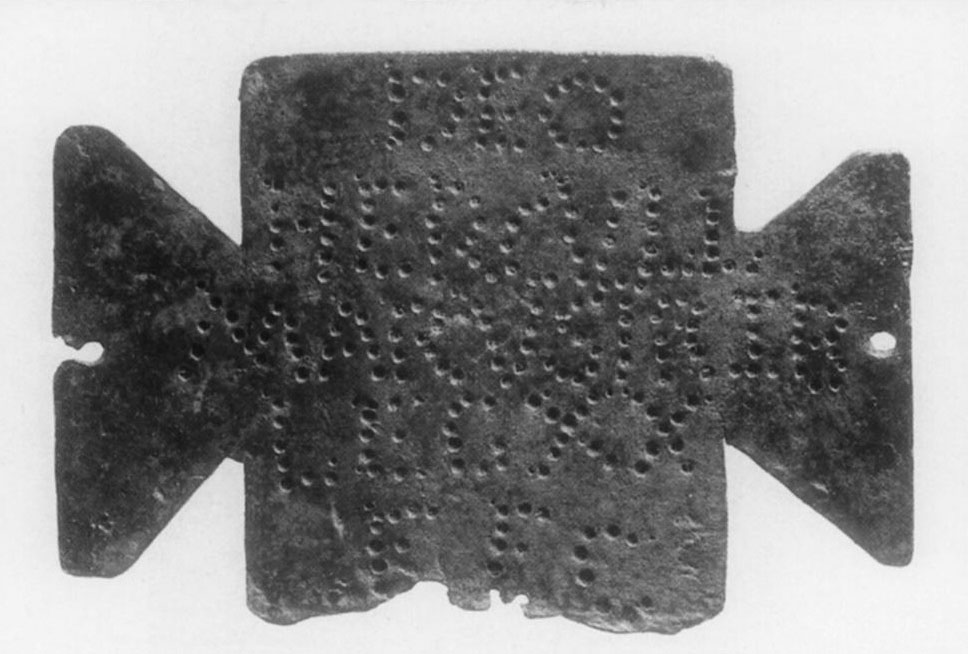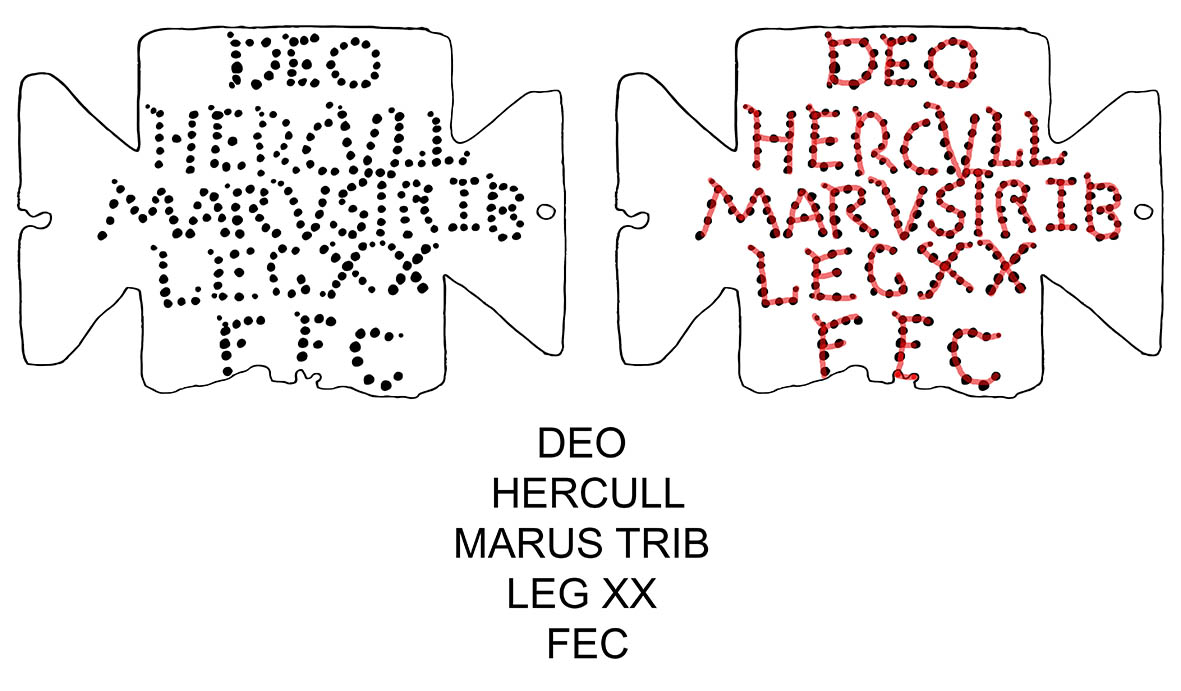Test your decipherment skills on a bronze plaque from Roman Britain
On a shelf in the Ashmolean’s Rome Gallery, eagle-eyed visitors might spot a tiny bronze plaque, with a rectangular body and triangular handles (a shape called a tabula ansata). At only 5cm tall, a dark greeny-brown and covered with dots, the plaque isn’t much to look at. But on close inspection (squinting helps), these dots form the letters of a Latin inscription. See how many you can make out before scrolling down:
Dot-to-dot decoding
The dots were made by hitting a round-tipped punch with a hammer, and have left the back of the plaque covered in tiny bumps. The punched letters are a bit wonky, don’t quite fit onto the plaque (the middle line spreads out onto the handles), and, worst of all, someone wrote ‘HERCULL’ instead of ‘HERCULI’ (even the Romans made spelling mistakes). But there has also been some care taken to centre the text, to make sure that words are not split up over line-breaks, and even to include little serifs which imitate fancier stone-carved letters. A serif (from the Dutch ‘screef’) is the small mark that can be added to the end of letter-stroke, giving a neat finish to the lines and, on stone, making it easier for the stonemason to compare the height of each letter. On our little tablet, smaller dots have been added, making little stems on the letters to make them look smarter. You can see these very clearly on the first letter of each line.
By Hercules!
As in the majority of Latin inscriptions, some of the words have been abbreviated to save space, effort and material. On our tablet, the abbreviations have saved 11 letters, and lots of punched dots. In full, it says:
Deo / Herculi/ Marus tribunus / legionis XX fecit
‘For the god Hercules, Marus, tribune of the 20th legion, made this.’
It’s a short inscription which tells us that the plaque was nailed up as an offering to Hercules by a Roman army officer stationed in Britain. Offerings like these were a way of asking or thanking the gods for support. It’s no surprise that Hercules, famous for his strength and courage, was the god of choice for Marus, the military man.
Since he tells us that he was a tribune, Marus was probably of equestrian rank, but the relatively modest scale of the bronze plaque suggests that he was one of the mid-ranking officers. Although the 20th legion spent much of its time stationed at Chester (Roman Deva), in north-west of England, near the border with Wales, the plaque was supposedly discovered on the opposite side of the county, at Benwell, near Newcastle and the Roman fort at Condercum. It’s possible that Marus set up this offering to Hercules while the legion was on active service near Hadrian’s Wall.
XX, VV, ??
In either AD 61 or AD 8, the 20th legion (or ‘LEG XX’ as Marus puts it) was rewarded for its bravery with the special honorific title Valeria Victrix. To keep things short, the 20th Legion Valeria Victrix often appeared in inscriptions as ‘LEG XX VV’. This was precisely the abbreviation we found in April 2014 when the AshLI team used special imaging software to read a disappearing inscription on an altar in the Ashmolean’s Ark to Ashmolean Gallery (here).
If Marus didn’t bother to include ‘VV’ on the plaque, it might mean that it was made before the legion was awarded the title, and could give us some clue to its date. But the letters might also just have been left out to save space. After all, Marus didn’t even have enough room to include his full name. The famous clay antefix on display in the British Museum,was made long after the legion got its new name, but still only has the basic ‘LEG XX’. Because our bronze plaque made its way onto the antiquities market without a proper archaeological record of where it was found, we may never really know exactly when it was that a Roman soldier went to Newcastle and punched Hercules…
c. 1st-2nd centuries AD (?). Ashmolean Museum AN2001.1. H. 0.49, W. 0.71, D. 0.1. On display in the Rome Gallery of the Ashmolean Museum.
A more detailed discussion of the plaque, with full bibliographic references, will appear in the new catalogue of the Ashmolean Latin Inscriptions, which will be freely available online before 2016.







1 comment for “The Roman soldier who went to Newcastle and punched Hercules”